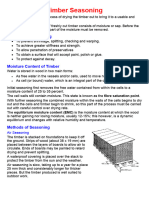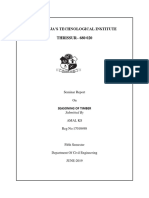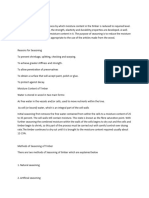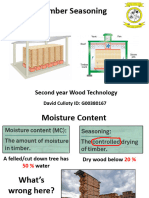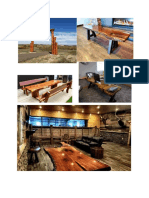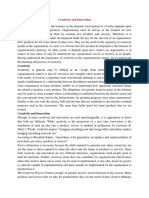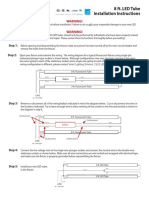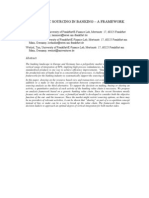Timber Seasoning
Uploaded by
Ellz LahCe Gimotea BaluyutTimber Seasoning
Uploaded by
Ellz LahCe Gimotea BaluyutTimber Seasoning
Timber is seasoned to dry out the timber to bring it to a usable and workable condition.
More than half the weight of freshly cut timber consists of moisture or sap. Before the
timber can be used a large part of the moisture must be removed.
Reasons for Seasoning
To prevent shrinkage, splitting, checking and warping.
To achieve greater stiffness and strength.
To allow penetration of preservatives
To obtain a surface that will accept paint, polish or glue.
To protect against decay.
Moisture Content of Timber
Water is stored in wood in two main forms:
As free water in the vessels and/or cells, used to move nutrients within the tree.
As cell (or bound) water, which is an integral part of the cell walls.
Initial seasoning first removes the free water contained from within the cells to a
moisture content of 25 to 35 percent.
The cell walls still contain moisture. This state is known as the fibre saturation point.
With further seasoning the combined moisture within the walls of the cells begins to dry
out and the cells and timber begin to shrink, so this part of the process must be carried
out with careful control over drying rate.
The timber continues to dry out until it is brought to the moisture content required,
usually about 12-15%.
Methods of Seasoning
Air Seasoning
The timber is stacked on foundations to keep it off
the ground. Strips of wood (about 38 x 19 mm) are
placed between the layers of boards to allow air to
circulate. Ends of boards may be painted to retard
drying and prevent splitting.
A waterproof covering is placed over the stack to
protect the timber from the sun and the weather.
Air seasoning is slow, taking up to a year for a piece
25 mm thick and considerably longer for thicker
pieces. But the timber produced is well suited to
outdoor work.
Kiln Seasoning
Kiln seasoning is done in a large oven-like structure in which air circulation, humidity
and temperatures are controlled. The timber is stacked on the trucks in the same way
as for air drying. The trucks are on rails so that they can be moved into the kiln.
Care must be taken to see that the drying process while removing the free water is not
too rapid, as at this stage the timber is susceptible to degrade (damage) by checking
and collapse.
Many types of softwood, such as Radiata Pine, can be kiln dried easily and fairly
cheaply from the green condition. But many of the Australian hardwoods are so slow in
drying that their kiln drying is uneconomical. It is, however, satisfactory and economic
to season them by the combined process of air and kiln drying mentioned below.
Types of Seasoning Kilns
Compartment Kilns
Circulation is induced by fans forcing air over heating coils and humidifying sprays and
through the timber stack.
The fans are reversible to allow uniform seasoning on each side of the stack. Kiln
conditions are uniform and can be regulated to suit the stage of seasoning.
Compartment kiln
Progressive Kilns
In this type of kiln the conditions at one end of the kiln differ from those at the other
end.
An unbroken line of trucks, all at different stages of drying, extends through the kiln. As
a truck of green timber enters at the cool, moist end, another is removed from the hot,
dry end ready for use; the drying process is continuous.
Heated air is circulated by fans along the kiln from the hotter and drier end to the
cooler and moister end. As it passes through the timber it gradually cools and picks up
moisture, thus, the drying conditions at the greener end are less than those at the dry
end.
Progressive kiln
Example of a Hildebrand progressive timber dry kiln (counterflow principle) which was installed in
1978 at BSW Timbers in Great Britain still in operation today.
Combined Seasoning
(a) The timber is first air dried for several months, the actual time depending on the
species of timber, thickness and climate. The slow air drying, until the free
moisture has been removed (i.e., to fibre saturation point 25-30% M.C.) reduces
the tendency to degrade by warping, checking and collapsing.
(b) The timber is then kiln dried to remove the combined moisture from the cell walls
to the required moisture content. This can be done rapidly in several days to a
week or so.
Advantages of Kiln Drying
(a) Kiln drying permits drying to the exact M.C. required, which may be much less
than that of air dried timber.
(b) The carefully controlled conditions can minimise degrade seasoning defects
which occur while drying.
(c) The heating of the timber while in the kiln kills eggs, larvae and adult borers
which may be present in the wood.
(d) Although capital costs may be higher, greater turnover is possible by reductions
in drying time, and less timber yard storage space required.
You might also like
- Code Number Fault Code Description Fault Code Information91% (11)Code Number Fault Code Description Fault Code Information35 pages
- Communication System by RP Singh and Sapre PDF33% (15)Communication System by RP Singh and Sapre PDF2 pages
- METHOD OF STATEMENT For HDPE Pipe Installation100% (5)METHOD OF STATEMENT For HDPE Pipe Installation18 pages
- Further Reading - Institute of Chartered ShipbrokersNo ratings yetFurther Reading - Institute of Chartered Shipbrokers5 pages
- SEASONING OF TIMBER & WOOD PRESERVATIONNo ratings yetSEASONING OF TIMBER & WOOD PRESERVATION17 pages
- Civilengineering - blog-SEASONING OF TIMBER AND ITS METHOD100% (1)Civilengineering - blog-SEASONING OF TIMBER AND ITS METHOD7 pages
- 1.WOOD. PREPARATION OF TIMBER:The Felling' of A Tree, Is The First Stage ofNo ratings yet1.WOOD. PREPARATION OF TIMBER:The Felling' of A Tree, Is The First Stage of21 pages
- Methods and Processes of Seasoning TimberNo ratings yetMethods and Processes of Seasoning Timber2 pages
- Fig. 37: Timber Stacking - in Pile: 6.3 Drying 6.3.1 Air-DryingNo ratings yetFig. 37: Timber Stacking - in Pile: 6.3 Drying 6.3.1 Air-Drying16 pages
- 1.WOOD. PREPARATION OF TIMBER:The Felling' of A Tree, Is The First Stage ofNo ratings yet1.WOOD. PREPARATION OF TIMBER:The Felling' of A Tree, Is The First Stage of10 pages
- Kiln Drying of Lumber A Practical and Theoretical Treatise 1917100% (1)Kiln Drying of Lumber A Practical and Theoretical Treatise 1917374 pages
- Question Bank: 2 Mark Question and AnswersNo ratings yetQuestion Bank: 2 Mark Question and Answers11 pages
- Chemicals Zetag DATA Organic Coagulants Magnafloc LT 7985 - 0410No ratings yetChemicals Zetag DATA Organic Coagulants Magnafloc LT 7985 - 04102 pages
- The Role of Creativity in EntrepreneurshipNo ratings yetThe Role of Creativity in Entrepreneurship21 pages
- Mains 15 J 20 J 36 J Level 1 Service Manual100% (1)Mains 15 J 20 J 36 J Level 1 Service Manual11 pages
- Talapaksaan: Ge 11: Pagsasalin Sa Filipino Iba'T Ibang Disiplina College Vision100% (1)Talapaksaan: Ge 11: Pagsasalin Sa Filipino Iba'T Ibang Disiplina College Vision18 pages
- 1404 E EUC 3 Manual and Automatic Compensation of Reactive PowerNo ratings yet1404 E EUC 3 Manual and Automatic Compensation of Reactive Power20 pages
- Artificial Intelligence For R-2017 by Krishna Sankar P., Shangaranarayanee N. P., Nithyananthan S.0% (1)Artificial Intelligence For R-2017 by Krishna Sankar P., Shangaranarayanee N. P., Nithyananthan S.8 pages







